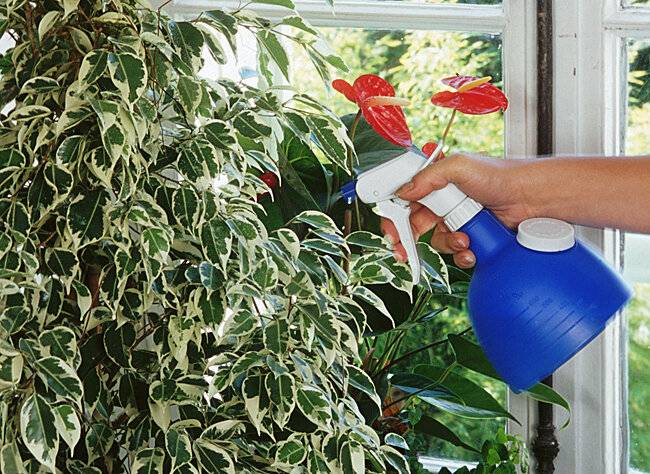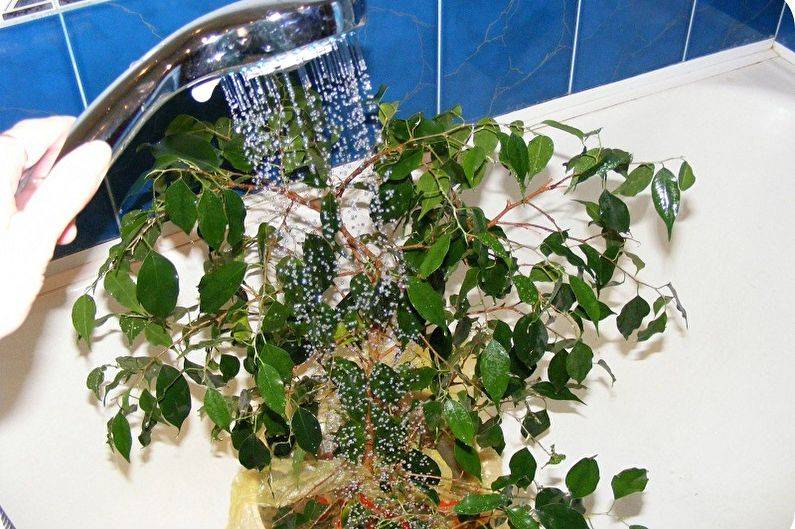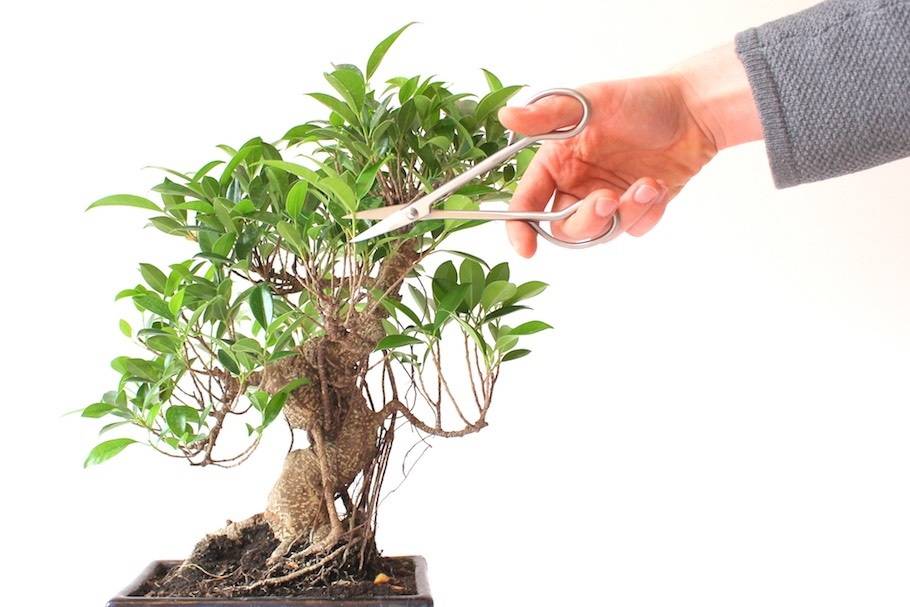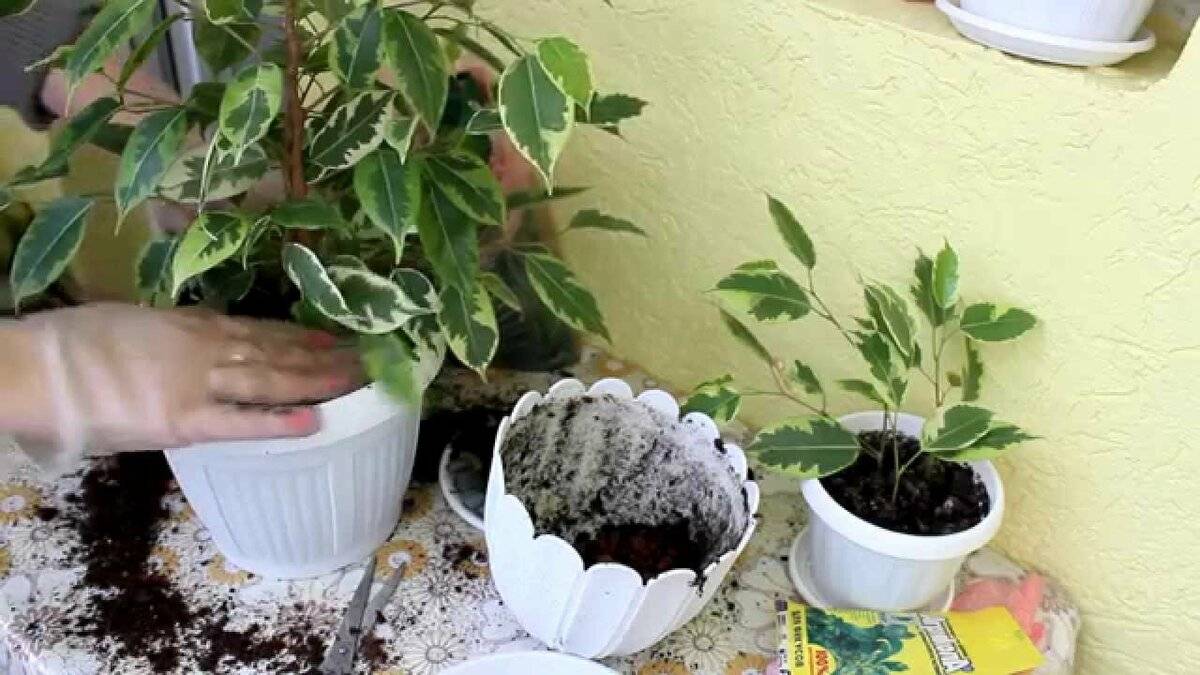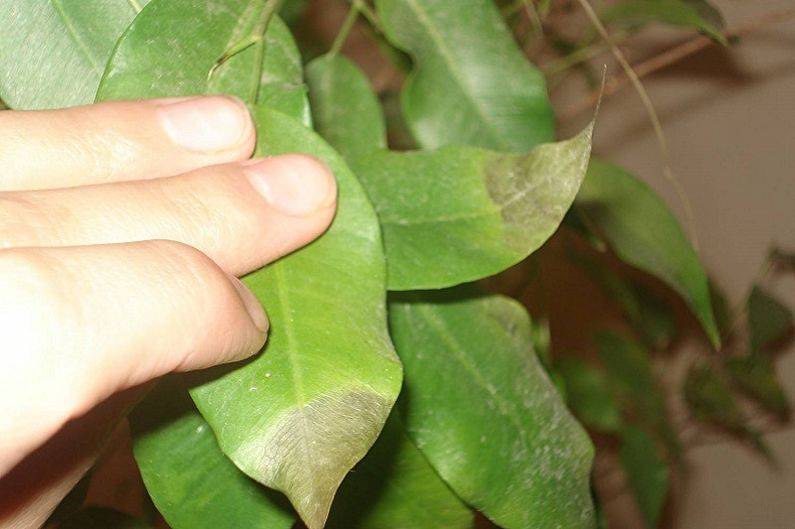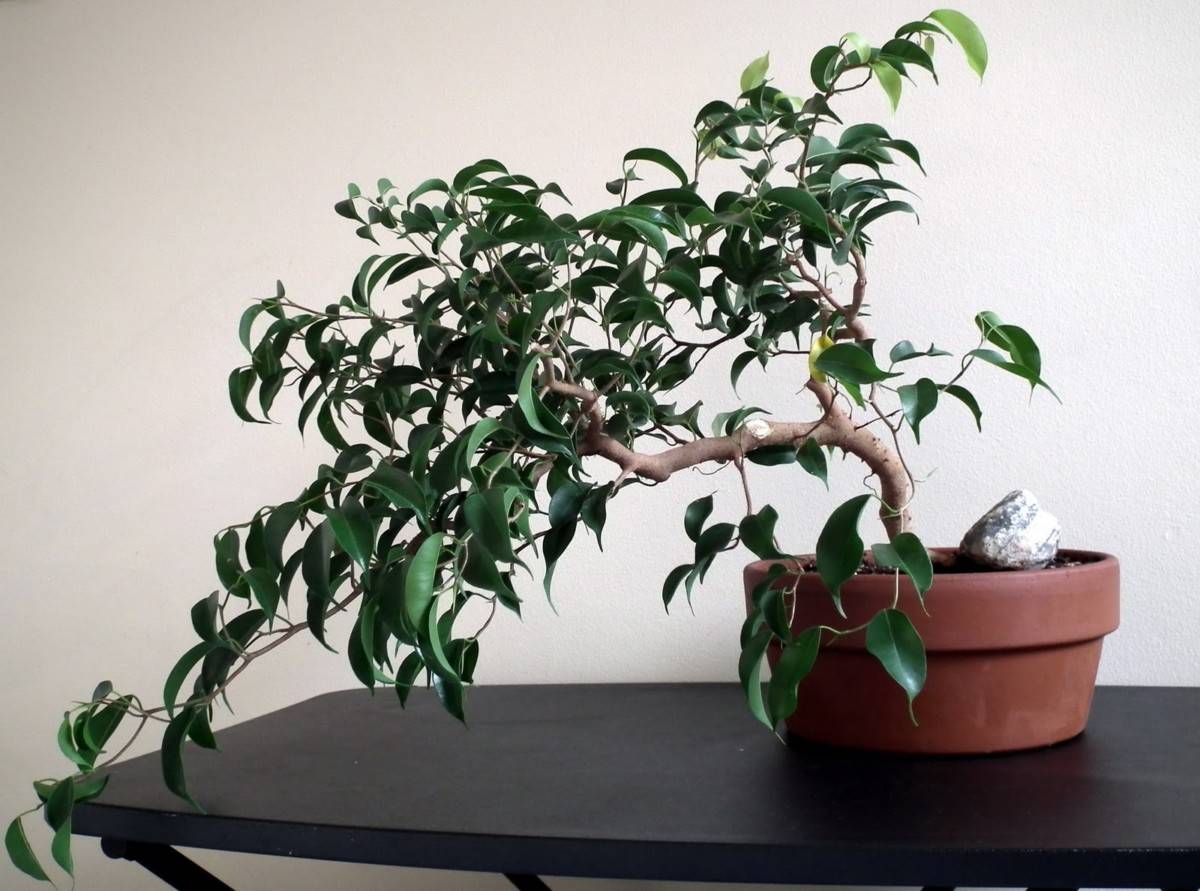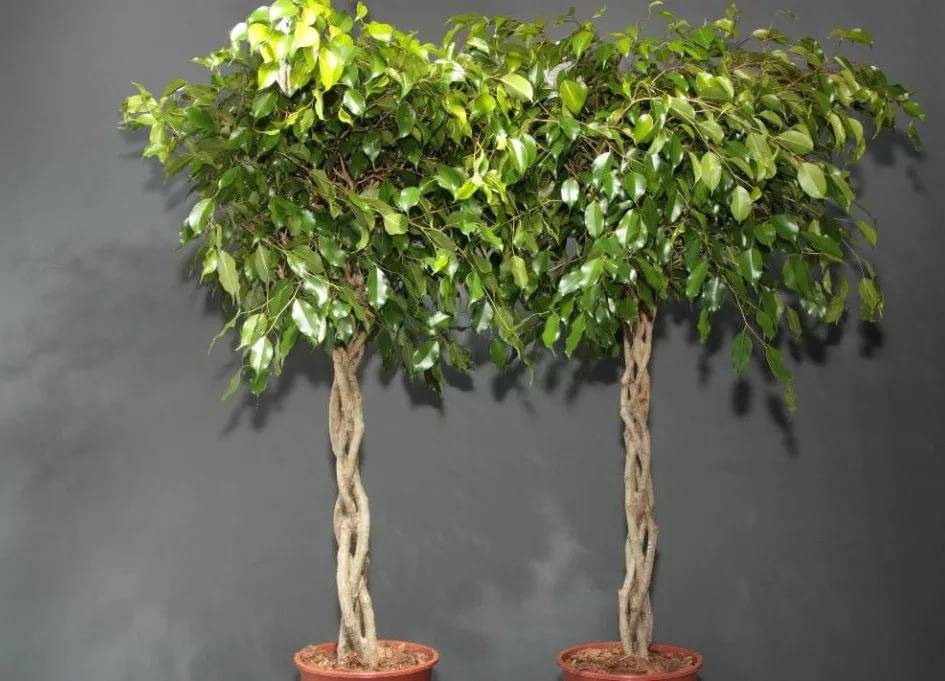How to care for ficus benjamin in a pot at home
Content:
Ficus benjamin is a beautiful houseplant with light leaves, somewhat reminiscent of birch leaves. Its appearance depends on the growing conditions. Novice gardeners are interested in how to care for a Benjamin ficus in a pot at home, why the ficus sheds its leaves and how to deal with it.
How to care for ficus benjamin
Ficus benjamin is a house potted plant. The size of the flower, the density and color of the leaves are directly related to the amount of fertilizing applied, the quality and mode of watering, the degree of illumination of the window sill. With properly organized care, the shrub adds 20 cm in growth per year. After 5-7 years, the plant no longer fits even on the most spacious windowsill, at 20 it turns into a branchy tree, at least 2-3 meters high.
Watering mode
Ficus loves moisture, but it is watered only when the top soil layer dries out by at least 1 cm. A match is used to check (if there is soil on it, it is too early to water). In summer, plants are moistened at least 2-3 times a week. In winter, the number of watering is reduced to 1 time in 7-10 days.
Ficus benjamin loves to be sprayed and even placed under a warm summer shower for a few minutes. For spraying, use water at room temperature, preferably boiled to avoid the appearance of white streaks on the leaves. Warm water can be poured into a basin and the plant can be lowered there with its crown down.
Top dressing
The trees are fed from March to September. To do this, use:
- fertilizers intended for palm and any deciduous;
- special feeding for ficuses;
- any fertilizing containing nitrogen;
- wood ash.
Apply fertilizers according to the instructions. An excessive amount of them harms the plant, especially if it was planted recently.
Preparing for winter
Ficus benjamin is a thermophilic tropical plant that can die if the indoor temperature drops below +16 degrees. Ideally, it should not fall below + 18-20 degrees Celsius. If the pot with the plant is on a cold floor in winter, you need to take care of insulation. To do this, use any heat insulator - felt, old newspapers and papers, warm clothes. Desirable:
- limit the contact of leaves with cold glass, it is better to move the pot away from the glass as far as possible or rearrange it from the windowsill to the table;
- plant in plastic pots, the heat lasts longer.
Ficus does not like direct sunlight, but in winter it is always illuminated with a lamp. A distance of 20-25 cm is maintained between the light source and the tree. The lamp is turned on for 8-14 hours. About once every 10-12 days, the pot with the plant is turned the other side. So all the leaves receive the amount of light they need. It is not advisable to change the location of the pot with the plant more often than once a year. If the ficus looks good and continues to grow, it is best not to touch it.
How ficus benjamin reproduces at home
Ficus is considered a fairly hardy and tenacious plant. It takes root well, there are no difficulties with reproduction even for beginners who have no idea how the benjamin ficus reproduces at home. Most often, young plants are grown from cuttings. But you can also use cuttings, leaves and even seeds.
Propagation by cuttings
To get a young sprout:
- on the mother plant, woody shoots are selected with a length of 5 to 15 cm (each should have 2-3 nodes);
- cut off shoots with a sharp knife;
- a small incision is made under the lower kidney with a knife;
- the cuttings are placed in a container of water for 1 hour, this helps to remove the juices that stand out;
- the sections are treated with a drug that stimulates root growth.
Prepared cuttings should be planted in a container filled with wet sand or a mixture of perlite and peat. The pot is covered with a film or glass jar. As the soil dries out, it is moistened. The air temperature is maintained in the room at the level of + 25-26 degrees. The first roots appear after 2-3 weeks.
How to root ficus benjamin at home
The rooting of ficus benjamin is facilitated by planting cuttings in fertile soil. Rooting occurs in the next few weeks if the shoot is rooted in a mixture of turf, sand and peat. It must first be ignited in the oven or spilled with hot water. The stalk is buried in the ground up to the third bud.
Young plants can also be propagated in a plastic glass of water, covered with another glass that acts as a greenhouse roof. Several ventilation holes are made in the upper glass. After the roots appear, the cuttings will have to be planted in separate pots.
Benjamin Ficus Pot
To root several small roots, they use ordinary plastic pots, their size does not matter, young plants await subsequent transplantation. If you need to root 5-6 cuttings, they are planted in rectangular containers, which are convenient to place on the windowsill.
The pot for an adult plant is chosen according to the size of the roots. In young ficuses, the root system is poorly developed, they are planted in small, almost flat containers. Mature plants need bulky pots. The material can be anything.
How to prune ficus benjamin
The tree does not need regular pruning. It is carried out in order to stimulate growth, to get rid of old leaves, sometimes it helps to form a beautiful crown.
How to form a ficus benjamin
Ficuses are cut in early spring. It is better to do this in March, early April. By the time the plant grows, the wounds it receives will heal. If pruning is done earlier or later than the specified period, the tree will weaken, may shed its leaves or dry out. You need a sharp knife or pruner to trim. You can use scissors, a paper knife. Tools are disinfected in alcohol or in a solution of potassium permanganate. Work better with gloves. Activated carbon is required to process the cut.
The step-by-step procedure is as follows:
- The plant is examined in order to identify dry and diseased branches, leaves.
- The ends of the young branches are cut straight. This will give the plant a fluffy appearance, and will ensure the rapid growth of new leaves and stems.
- Cuts of old branches are treated with activated charcoal or garden pitch, young branches also need a similar treatment, the juice that has come out is removed with a damp cloth.
In the process of pruning, the ficus is given the following shapes:
- Stamp. The crown is cut with a ball or oval. Young trees are regularly pruned, leaving only the upper 3-4 branches, everything that grows on the sides is removed.
- Arc. The formation of the crown begins during rooting. To give the desired shape, the trunk of the plant is wrapped with wire.
- Bush. To grow not a tree, but a bush nearby, several cuttings are planted. As they grow, they are pinched and many side shoots are left.
Sometimes the crown can be formed into a pyramid. To do this, the lower branches are left intact, the upper ones are cut off so that the top turns out to be pointed.
Ficus benjamin transplant
Ficuses are transplanted annually for the first 4 years. Adult plants over 5 years old are transplanted every 2-3 years. In this case, the topsoil is changed annually.
The choice of soil for ficus benjamin
Transplant soil should consist of:
- sand (1 part);
- coniferous land (2 parts);
- peat (2 parts).
River pebbles or expanded clay are used as drainage. Transplanted like this:
- The plant is removed from the pot, the roots are shaken off from the previous earthen coma, washed under a stream of warm water or in a solution of potassium permanganate.
- Drainage is laid at the bottom of the new pot.
- Sprinkle with sand on top.
- Ficus is placed in the center of the pot, covered with earthen mixture, and then tamped.
- The transplanted ficus is watered and sprayed with warm water.
Why does the ficus shed its leaves
Not knowing why the leaves of the ficus sometimes turn yellow and fall off, they pay attention to the following provoking factors:
- improper care (insufficient or excessive watering, untimely attempt to feed the tree);
- transplant at the wrong time of the year;
- frequent movement from place to place in the house;
- a sharp drop in temperature;
- trying to trim a bush in winter or summer;
- lack of necessary lighting, direct sunlight on the leaves;
- diseases and pests.
If you water the plant with cold water or refuse regular spraying, then it will also shed its foliage.
Diseases and pests
Ficus is a very delicate plant that gets sick at the slightest change in growing conditions. Florists should be wary of the development:
- Cercospora. The leaves are covered with small black or brown spots. After a while, they turn yellow and fall off. The disease develops with overflow. Spraying with fungicides containing copper or sulfuric solution may help. You can get the required substances at a flower shop. All diseased parts of the plant are removed.
- Atracnose. The leaves are covered with rusty spots. They need to be removed. The plant is transplanted. It is imperative to change the conditions of detention.
Improper care or lack of it causes the appearance of swelling and large black spots on the leaves. Processing with special means will not help. Ficus can be saved from death only by transplanting and removing damaged areas. A sharp deterioration in appearance is also associated with the appearance of:
- mealybug;
- centipedes;
- scabbards;
- thrips;
- whitefly;
- spider mites;
- aphids.
In the fall, ficus can shed its leaves for natural reasons. If it happens at another time of the year, it may be infected with root or crown rot, Phomopsis ulcer. To prevent this from happening, overflow of the plant should be avoided, all instruments used during transplantation must be disinfected.
Weaving ficus benjamin
Young shoots of ficus can be intertwined in various ways. This allows you to create an unusual interior. Ficuses can be twisted with a pigtail, spiral, hedge or trellis. Each type of weaving has its own characteristics.
How to braid Benjamin's ficus at home
A pigtail is the simplest way to weave the trunk of a benjamin ficus. They begin to weave it 3 months after transplanting the cuttings into a permanent pot, choosing stems of the same height and thickness for weaving. They need to be braided together, twisting them in a spiral and fixing them over with a tape, or, if the stems are still very soft, make a braid. This will require at least 3 identical processes, all the stems remaining on the sides are simply cut or pushed between the braids, trying to make them part of the weaving.
Ficus benjamin is a thermophilic houseplant. Young ficuses fit well on the windowsill, but they grow quickly. After 5-7 years, the plants will have to be moved to the floor in a large tub. In order for the ficus to please with its beauty, proper care is necessary. The main thing is lighting and watering. If everything is done correctly, the tree will grow for a long time. Improper maintenance leads to leaf fall, loss of resistance to pests and diseases.

